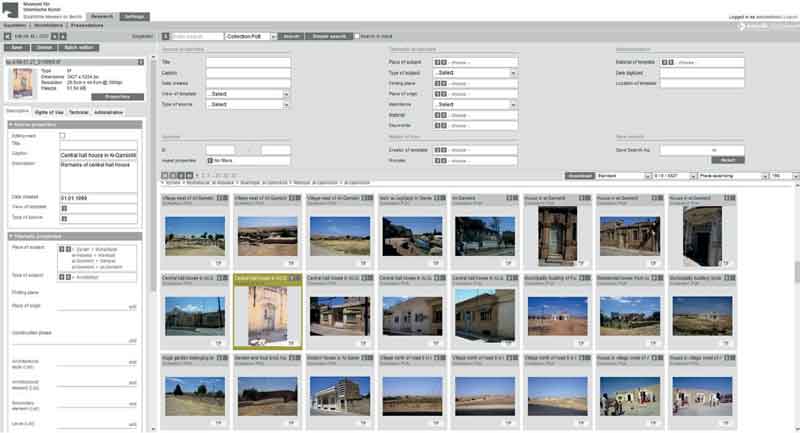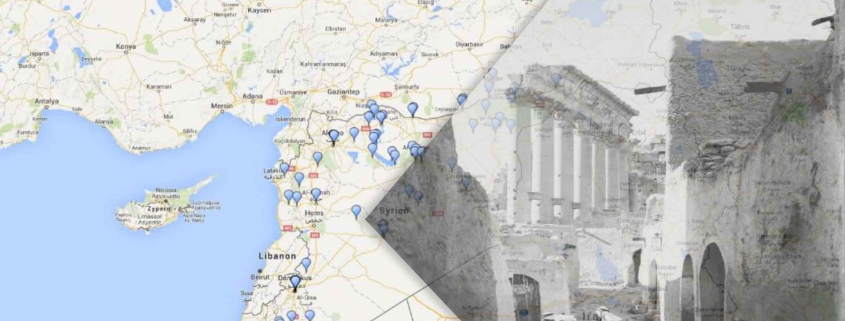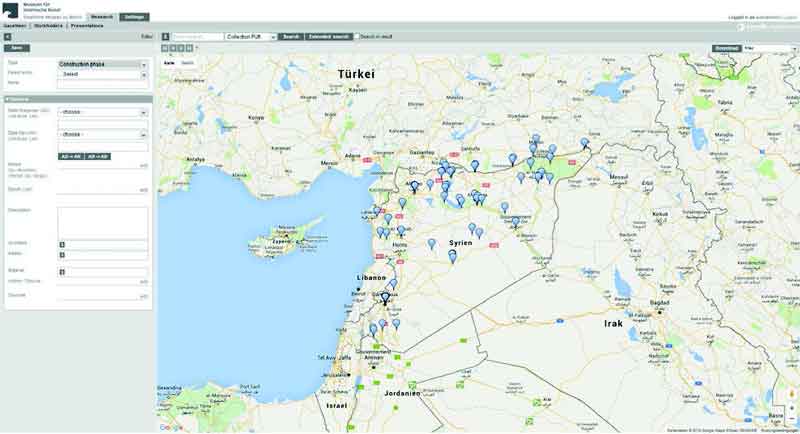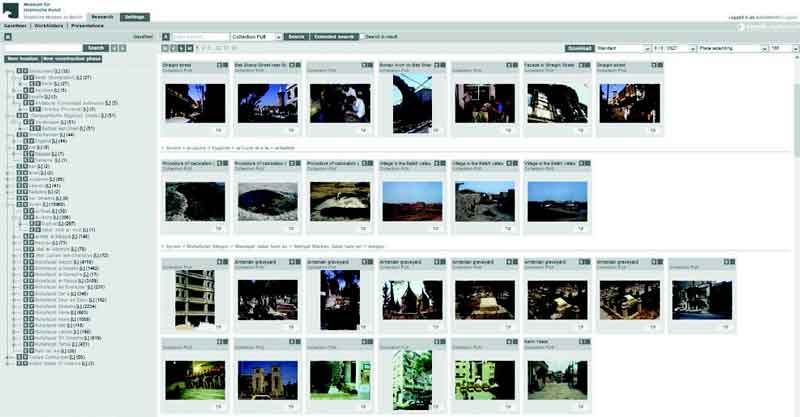Syrian Heritage Archive Project

Online-Archiv für ein Kulturgüter-Register syrischer Denkmäler
„Wir setzen alles daran, mithilfe der Digitalisierung das Kulturerbe und die syrische Identität bestmöglich zu dokumentieren und zu bewahren. Modular vernetzte, standardkonforme, webbasierte Datenbanklösungen sind hierbei unverzichtbare Arbeitswerkzeuge. Für uns war wichtig, dass wir mit easydb unsere besonderen Anforderungen realisieren konnten.“
Issam Ballouz, Architekt Team Syrian Heritage Archive Project Freunde des Museums für Islamische Kunst e.V
Hintergründe und Ziele des Projekts
Der nun seit mehreren Jahren anhaltende Konflikt in Syrien bedroht das Leben der Menschen sowie das herausragende syrische Kulturerbe und damit wichtige zeithistorische Dokumente und bedeutende Pfeiler syrischer Identität. Eine umfassende wissenschaftliche Dokumentation der syrischen Kulturlandschaft stand bisher noch aus. International und auf syrischer Seite haben es sich Teams zur Aufgabe gemacht, das syrische Kulturgut systematisch zu erschließen und digital in Archiven zu sichern. Ziel ist es, die Archivdaten für ein übergreifendes Kulturgüter-Register für Syrien zu nutzen und zur Verfügung zu stellen.
Eines der partizipierenden Projekte ist das Syrian Heritage Archive Project – ein Kooperationsprojekt zwischen dem Museum für Islamische Kunst der Staatlichen Museen zu Berlin und dem Deutschen Archäologischen Institut (DAI). Gefördert wird das Projekt durch das Kulturerhalt-Programm des Auswärtigen Amtes und durch den Freundeskreis des Museums für Islamische Kunst e.V. unterstützt.
Onlinearchiv für das syrische Kulturgut
Im November 2013 haben das Museum für Islamische Kunst und das DAI angefangen, ihre Archivbestände zu digitalisieren. Beide Institutionen verfügen durch jahrelange Forschungsarbeiten über große Mengen von analogem Material: Fotos, Dokumentationen, Pläne und Karten. Ein syrisch-deutsches Team hat sich der Aufgabe angenommen, das Material des Museums für Islamische Kunst systematisch zu erschließen und auf der Objektdatenbank des DAI [iDAI.objects/Arachne], bereit zu stellen. Eine Hinwendung nach Syrien und zu den Syrern war und ist Grundbedingung der Arbeit. Das Projektteam sichtete und analysierte das Material im Zuge der Inventarisierung des Archivbestands und erarbeitete auf dieser Basis ein Datenmodell zur Erfassung des Kulturerbes.
Technische und dokumentarische Anforderungen
In der ersten Projektphase wurde für die Verwaltung der mittlerweile digitalisierten Bestände des Museums die webbasierte Technologie easydb eingeführt und die Datenbank entsprechend den Anforderun- gen des Projekts modifiziert. Wichtig war die hohe Flexibilität und Anpassungsfähig- keit von easydb, um das Archiv im internationalen Kontext des Vorhabens nachhaltignutzbar zu machen.
Für die Datenmodellierung wurde ein interdisziplinärer Ansatz gewählt, der die multidimensionale Genese des Kulturerbes Syriens abbildet. Mit dem Ansatz verfolgt das Team das Ziel, einen Beitrag für das Kulturerbe-Register, das der Kartierung deskulturellen Bestands dient, zu leisten und sich gleichzeitig an den Bemühungen um einen international greifenden, methodi-schen Ansatz zur Dokumentation des syrischen Kulturguts zu beteiligen.
Ansatz der Datenordnung
Die Zuordnung aller Bildobjekte wird primär geografisch determiniert, sichtbar durch eine links eingeblendete hierarchisierte Ortsliste. Diese wird regelmäßig mit dem Online-Ortslexikon des DAI (iDAI.Gazetieer) und den darin enthaltenen Ortsbeschreibungen synchronisiert. Bauliche Objekte sind unterteilt in Erstellungs- und Nutzungs- phasen. Die spezifische Beschreibung der Bildobjekte erfolgt systematisch nach Vorlage, Motiv und digitalem Objekt.
International und transdisziplinär
Die Erfassungsstruktur in easydb berücksichtigt verschiedene Aspekte und ist in drei Teile gegliedert: 1) geografische, 2) archäologische und architektonische sowie 3) humane und soziale Informationen. Damit wird ein wichtiger Beitrag zum Erhalt des Kulturerbes und des „kulturellen Gedächt- nisses“ geleistet und ein multiperspektivischer Zugang zu den Daten ermöglicht. Die Datenbank soll künftig der syrischen Bevölkerung, der interessierten Öffentlichkeit sowie der internationalen Community für den Wiederaufbau, Rekonstruktionen und eine interdisziplinäre Auseinandersetzung mit Syrien zur Verfügung stehen.
Normdaten, Standards, Dienste
Eine wichtige Rolle spielt die Datenerfas- sung durch eine heterogene Fachcommunity. Die Datenstruktur berücksichtigt bei den Themen Landschaften und Gebautes die Einbindung von Informationen zur Verwaltung und zum Zustand, die aus einer weiteren Datenbank (Gebäude- und Schadensinformationssystem) importiert werden. Letztere lehnt sich an den Standard EN 16096:2012, Erhaltung des kulturellen Erbes – Zustandserhebung und Bericht für das gebaute Kulturerbe, an. Um eine einheitliche Eingabe und internationale Lesbarkeit zu gewährleisten, werden die Felder vorwiegend durch Wertetabellen und Einbindung von Thesauri und Normdiensten befüllt. Im Sinne von Linked Data werden Quellen durch URIs angegeben und auf bewährte Dienste und Standards wie AAT (Art & Architecture Thesaurus), iDAI.Gazet- teer (geografisches Ortslexikon des DAI), iDAI.bibliography (für Literatur), Gemeinsame Normdatei (GND) der Deutschen Nationalbibliothek, WorldCat, Wikidata und VIAF zurückgegriffen. Für Freitextfelder ist die Angabe der Autorenschaft/Quelle obligatorisch. Die Umrechnung des islamischen Kalenders in die gregorianische Zeitrechnung und umgekehrt wurde in easydb berücksichtigt. Das Online-Archiv wird neben der englischen Sprache auch auf Arabisch und Deutsch bereitgestellt.
Rechtevewaltung und Datentransfer
Die künftige Verwendung der Daten und Inhalte soll möglichst zugänglich und transparent sein. Eine grundlegende Recherche und Klärung von Autorenschaft und Verwertungsrechten stellt dies sicher. Die Daten für den Export werden ferner im international etablierten Format LIDO bereitgestellt, um den Datentransfer mit bereits bestehenden Datenbanken und Web-Portalen sicherzustellen.
www.syrian-heritage.org

Fallstudie als PDF
Making curated knowledge accessible for generations
Seit 15 Jahren sind wir mit easydb innovativer Pionier im Bereich web-basierter Medien-Repositorien. Zusammen mit der neusten Version fylr, dem Nachfolger von easydb 5, vertrauen Kunden in über 200 Installationen auf unsere Erfahrung und unser Know-how. Aufgrund des wissenschaftsnahen und individuellen Ansatzes, ist das System besonders in Bildungs- und Forschungseinrichtungen etabliert und bisher in über 50 Pressestellen unverzichtbar geworden.
Unser Expertenteam steht Ihnen für Ihre individuellen Anfragen zur Verfügung.





